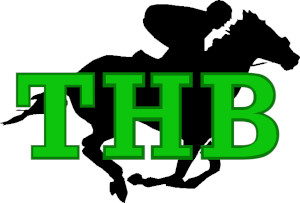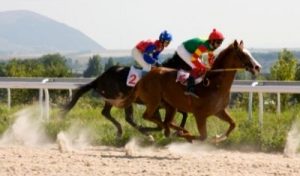There are fundamental differences in horse breeding and body structure that factor into whether a race horse is a “turf horse” or “dirt horse”. We’ll talk about these differences and how they impact a horse’s ability to win races in this article.
Characteristics of Turf (Grass) vs. Dirt Tracks
First, let’s talk about how the two surfaces differ under varying conditions:
Turf Characteristics
- In ideal conditions when turf is moderately moist and has been clipped to a mid-length, the grass has a slick upper layer and a firm, but padded lower root layer. The horse primarily runs on the top surface, only digging into the lower root layer when launching from the gate. It is very comfortable for horses to run on moist grass, as the roots provide a cushion and there is plenty of grip. This is a fast and safe surface, assuming it’s flat and there are no holes or undulations to trip the horses up or make them drift. As the lush grass softens their stride and there are no clods of dirt or dust striking the horse and rider, turf racing is less taxing on a horse’s body than racing on a dirt track.
- In dry conditions, turf can get thin and hard. The top layer of grass thins out as it loses moisture, exposing the roots and dirt below. This is known as hard pan. It is a fast surface that is easier to run on, but it can be hard on a horse’s joints. Ligher, taller horses tend to run better on hard grass.
- In very wet conditions, such as after heavy rains, the roots become saturated and the entire surface layer is penetrated with each hoof fall. This takes a lot of energy for a horse to run through, slowing the horses as they have to power their way over the mud and forward. It is also slippery, adding risk to the horse and jockey. Strong horses tend to run better in muddy conditions.
- If the grass is cut long, it becomes more slippery and difficult for the horse’s hooves to dig into. The long grass drag on the hooves as they are lifted to move forward. A heavier, taller horse will tend to do better in long grass situations. As the thick grass may partly impede a thoroughbred’s foot, race timings on the green also tend to be slower.
Dirt Characteristics
- Ideal conditions for a dirt track is medium moisture, with the top surface churned and smoothed and no clumps or clods. This is a fast surface for horses that have a natural proclivity to running on dirt.
- In dry conditions, the dirt can become thin and dusty over a hard bottom layer. Hooves cannot drive off the dusty dirt as hard, and they cannot dig into the hard bottom layer. This makes it challenging for big, heavy horses and an advantage for lighter horses that glide over the dust easier. The dust being thrown up also interferes with vision and breathing, so it pays to run out front.
- After heavy rains, dirt surfaces turn to mud. This dramatically changes the racing conditions and adds risk to horses and jockeys. It takes a lot more energy to run in the mud, and the pace is naturally much slower so strong horses who can power through the mud tend to do better.
Why do some horses run on turf and some on dirt?
What makes a horse better on turf?
Foot size and gait of the horse determines if it runs better on turf. A horse’s ability to handle the grass is greatly influenced by those three factors.
Grass horses have smaller hoof size and raise their legs higher when they run. This helps them dig into the roots and generate more forward drive, while reducing drag on the foot with the smaller hoof size and raising them above the tops of the grass, rather than dragging them through the grass. This effect gets stronger if the grass is cut long.
Big flat-footed horses, sometimes known as pie plates, can run longer and more smoothly in soft conditions by grabbing the upper surface of the ground, rather than sinking in at every hoof fall.
Do race horses run faster on dirt or turf?
Turf races often have a leisurely start, followed by a dash to the finish. This rewards taller, thinner horses with greater endurance, rather than heavier, stocky horses that get out of the gates quickly.
Dirt races tend to have a quick start, with a slower end. Horses that run well on dirt launch strongly from the gates, but may run out of endurance at the end.
It is difficult to compare dirt vs. grass race tracks because they cannot be interchanged. Dirt horses are bred and run on dirt tracks, and turf horses bred and run on grass tracks, so they normally don’t run against each other often.
Under ideal moisture conditions, a dirt track will tend to be faster than a grass track. A moist dirt surface allows the horse to drive forward without pushing through a slippery grass layer.
A dry, dusty dirt track will tend to be slower than a dry grass track cut low. Dust loses its ability to hold the horse’s weight as it drives forward and flies in the air, reducing visibility and air quality.
A very wet, saturated dirt track vs. a saturated grass track are similar. They both become treacherous, slippery and lose visibility. The grass layer can easily tear away revealing mud below. Whether the dirt vs. gras track is faster depends on how much hard gravel is below the surface that the horses can find purchase on.
How does rain affect dirt tracks?
Moderate rain for short periods moistens a dirt track and keeps it in the ideal range for racing horses.
No rain for extended periods allows the dirt to dry out and become dusty. If the top layer is thick, this can slow the track down and make visibility difficult as dust gets thrown up during the race. If the top layer is thin, a dry dusty track can become slippery and difficult to launch.
Heavy rain for extended periods saturates a dirt track, turning it to slippery mud and creating a treacherous surface. If the dirt has a high sand content then it becomes soft and heavy, and less slippery. If the dirt has a high clay content, it turns into sticky mud. Puddles can form as well. Horses have a difficult time running in thick mud, slipping and drifting into each other.
This video on horse racing surfaces helps describe the pros and cons of dirt vs. turf tracks:
Related Questions and Answers
How many lengths does a horse run per second on turf?
In heavy going conditions, when horses travel more slowly at four lengths-per-second, as opposed to six lengths-per-second in a flat turf race in excellent going conditions.
Where are tracks made of turf?
In Europe, Canada and sub-tropical areas (Hong Kong, N. Australia, etc.) where the environment is wet, the most predominant track surface is turf.
The most typical track surface in the USA is dirt.
Is the Belmont run on grass or dirt?
Belmont is a dirt track.
Is the Kentucky Derby run on grass or dirt?
The Kentucky Derby at Churchill Downs is run on the dirt track. The racetrack is a “12-inch durable clay foundation on top of a 25-foot sandy loam sub-base.”
Is Churchill Downs a dirt track?
The 147-acre racetrack has both a one-mile oval racetrack made of dirt and a seven-furlong grass racetrack.
What surface is Gulfstream Park?
Gulfstream Park has a dirt racing track.
What is Tapeta in horse racing?
Tapeta is a surface used for thoroughbred racing and training that is made of silica sand, wax, and fibers that mimic the root structure of grass. Tapeta has been tried and tested in a variety of conditions and is designed to be more stable across different surface conditions than dirt or turf.
Conclusion
Race horses tend to run faster on dirt than on turf in ideal moisture conditions. There are many factors that contribute to the speed of a horse, and the surface they run on is one of them. Each one has its own advantages and disadvantages. Reference: horse race track surfaces.
Related Tags
- are horses faster on dirt or turf
- horse racing track conditions explained
- horse racing track types
- the racing surface
- race tracks with synthetic surfaces

I am Lawrence (aka “The Horse Better”). I spent 20+ years in financial risk management where I ran large-scale statistical betting models in complex situations. I grew up around horses and I’ve been betting on horse races for about 10 years with good success. I hope my articles provide good value!

